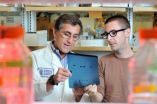(Press-News.org) PHILADELPHIA — Renaissance architects demonstrated their understanding of geometry and physics when they built whispering galleries into their cathedrals. These circular chambers were designed to amplify and direct sound waves so that, when standing in the right spot, a whisper could be heard from across the room. Now, scientists at the University of Pennsylvania have applied the same principle on the nanoscale to drastically reduce emission lifetime, a key property of semiconductors, which can lead to the development of new ultrafast photonic devices.
The research was conducted by associate professor Ritesh Agarwal, postdoctoral fellows Chang-Hee Cho and Sung-Wook Nam and graduate student Carlos O. Aspetti, all of the Department of Materials Science and Engineering in Penn's School of Engineering and Applied Science. Michael E. Turk and James M. Kikkawa of the Department of Physics and Astronomy in the School of Arts and Sciences also contributed to the study.
Their research was published in the journal Nature Materials.
"When you excite a semiconductor, then it takes a few nanoseconds to get back to the ground state accompanied by emission of light," Agarwal said. "That's the emission lifetime. It's roughly the amount of time the light is on, and hence is the amount of time it takes for it to be ready to be turned on again.
"If you're making a modulator, something that switches back and forth, you're limited by this time constant. What we've done is reduced it to less than a picosecond. It's more than a thousand times faster than anything currently available."
In semiconductors, the excited state is when energy is present in the system, and the ground state is when there is none. Normally, the semiconductor must first "cool down" in the excited state, releasing energy as heat, before "jumping" back to the ground state, releasing the remaining energy as light. The Penn team's semiconductor nanowires, however, can jump directly from a high-energy excited state to the ground, all but eliminating the cool-down period.
The advancement in emission lifetime is due to the unique construction of the team's nanowires. At their core, they are cadmium sulfide, a common nanowire material. But they are also wrapped in a buffer layer of silicon dioxide, and, critically, an outer layer of silver. The silver coating supports what are known as surface plasmons, unique waves that are a combination of oscillating metal electrons and of light. These surface plasmons are highly confined to the surface the silicon dioxide and silver layers meet.
"The previous state of the art was taking a nanowire, just like ours, and laying it on a metal surface," Agarwal said. "We curved the metal surface around the wire, making a complete nanoscale plasmonic cavity and the whispering gallery effect."
For certain nanowire sizes, the silver coating creates pockets of resonance and hence highly confined electromagnetic fields within the nanostructure. Emission lifetime can then be engineered by precisely controlling high intensity electromagnetic fields inside the light-emitting medium, which is the cadmium sulfide core.
To reach an emission lifetime measured in femtoseconds, the researchers needed to optimally balance this high-confinement electromagnetic field with an appropriate "quality factor," the measurement of how good a cavity is at storing energy. To complicate matters, quality factor and confinement have an inverse relationship; the higher the quality-factor a cavity has the bigger it is and the smaller its confinement. However, by opting for a reasonable quality factor, the researchers could vastly increase the confinement of the electric field inside the nanowire by using resonant surface plasmons and get the record-breaking emission lifetime.
This many-orders-of-magnitude improvement could find a home in a variety of applications such as LEDs, detectors and other nanophotonic devices with novel properties.
"Plasmonic computers could make good use of these nanowires," Cho said. "We could increase modulation speed into the terahertz range whereas electronic computers are limited to a few gigahertz range."
"The same physics governs emission and absorption, so these nanowires could also be used for increasing efficiency of absorption in solar cells," Agarwal said.
###
The research was supported by the U.S. Army Research Office, the National Institutes of Health, the National Science Foundation, Penn's Nano/Bio Interface Center and the U.S. Department of Energy.
Penn: Nanoplasmonic 'whispering gallery' breaks emission time record in semiconductors
2011-07-25
ELSE PRESS RELEASES FROM THIS DATE:
Earliest watery black hole discovered
2011-07-25
Pasadena, CA— Water really is everywhere. A team of astronomers have found the largest and farthest reservoir of water ever detected in the universe—discovered in the central regions of a distant quasar. Quasars contain massive black holes that are steadily consuming a surrounding disk of gas and dust; as it eats, the quasar spews out huge amounts of energy. The energy from this particular quasar was released some 12 billion years ago, only 1.6 billion years after the Big Bang and long before most of the stars in the disk of our Milky Way galaxy began forming.
The research ...
Can feeling too good be bad? Positive emotion in bipolar disorder
2011-07-25
Positive emotions like joy and compassion are good for your mental and physical health, and help foster creativity and friendship. But people with bipolar disorder seem to have too much of a good thing. In a new article to be published in the August issue of Current Directions in Psychological Science, a journal of the Association for Psychological Science, psychologist June Gruber of Yale University considers how positive emotion may become negative in bipolar disorder.
One of the characteristics of bipolar disorder is the extreme periods of positive mood, or mania. ...
Farthest, largest water mass in universe discovered
2011-07-25
An international team of astronomers led by the California Institute of Technology and involving the University of Colorado Boulder has discovered the largest and farthest reservoir of water ever detected in the universe.
The distant quasar is one of the most powerful known objects in the universe and has an energy output of 1,000 trillion suns -- about 65,000 times that of the Milky Way galaxy. The quasar's power comes from matter spiraling into the central supermassive black hole, estimated at some 20 billion times the mass of our sun, said study leader Matt Bradford ...
Shining a light on the elusive 'blackbody' of energy research
2011-07-25
CHESTNUT HILL, MA (July 22, 2011) – A designer metamaterial has shown it can engineer emitted "blackbody" radiation with an efficiency beyond the natural limits imposed by the material's temperature, a team of researchers led by Boston College physicist Willie Padilla report in the current edition of Physical Review Letters.
A "blackbody" object represents a theorized ideal of performance for a material that perfectly absorbs all radiation to strike it and also emits energy based on the material's temperature. According to this blackbody law, the energy absorbed is equal ...
Life scientists use novel technique to produce genetic map for African Americans
2011-07-25
UCLA life scientists and colleagues have produced one of the first high-resolution genetic maps for African American populations. A genetic map reveals the precise locations across the genome where DNA from a person's father and mother have been stitched together through a biological process called "recombination." This process results in new genetic combinations that are then passed on to the person's children.
The new map will help disease geneticists working to map genetic diseases in African Americans because it provides a more accurate understanding of recombination ...
Cellular stress can induce yeast to promote prion formation
2011-07-25
It's a chicken and egg question. Where do the infectious protein particles called prions come from? Essentially clumps of misfolded proteins, prions cause neurodegenerative disorders, such as mad cow/Creutzfeld-Jakob disease, in humans and animals. Prions trigger the misfolding and aggregation of their properly folded protein counterparts, but they usually need some kind of "seed" to get started.
Biochemists at Emory University School of Medicine have identified a yeast protein called Lsb2 that can promote spontaneous prion formation. This unstable, short-lived protein ...
NASA catches 3 tropical cyclones at 1 time
2011-07-25
It's not often that a satellite can capture an image of more than one tropical cyclone, but the GOES-13 satellite managed to get 3 tropical cyclones in two ocean basins in one image today. Bret and his "sister" Cindy are racing through the North Atlantic, while another area tries to develop far to their south. "Cousin" Dora is still a hurricane in the eastern Pacific.
In infrared image taken on July 22 at 0845 UTC (4:45 a.m. EDT), GOES-13 captured Tropical Depression Bret, Tropical Storm Cindy in the north Atlantic and low pressure area associated with a tropical wave ...
Northwest Forest Plan has unintended benefit – carbon sequestration
2011-07-25
CORVALLIS, Ore. – The Northwest Forest Plan enacted in 1993 was designed to conserve old-growth forests and protect species such as the northern spotted owl, but researchers conclude in a new study that it had another powerful and unintended consequence – increased carbon sequestration on public lands.
When forest harvest levels fell 82 percent on public forest lands in the years after passage of this act, they became a significant carbon "sink" for the first time in decades, absorbing much more carbon from the atmosphere than they released. At the same time, private ...
New target found for nitric oxide's attack on salmonella bacteria
2011-07-25
A new target for nitric oxide has been revealed in studies of how it inhibits the growth of Salmonella. This bacterium is a common cause of food-poisoning.
"Nitric oxide is naturally produced in the nose and the gut and other tissues in the body to ward off infection," explained the senior author of the paper, Dr. Ferric Fang. He is a University of Washington (UW) professor of laboratory medicine, microbiology and medicine.
Nitric oxide – not to be confused with nitrous oxide, the laughing gas in dentists' offices – is similar to the preservatives in hotdogs, Fang ...
2 genetic variations predict second cancers after radiation for children with Hodgkin lymphoma
2011-07-25
A genome-wide association study published in the August issue of Nature Medicine has found two tiny genetic variations that can predict which patients with Hodgkin's lymphoma are most likely to develop radiation-induced second cancers years after treatment. Knowing in advance who is at risk could help physicians tailor treatment to reduce the risks for patients who are most susceptible to long-term damage.
Hodgkin's lymphoma is one of the most treatable cancers, with more than 90 percent of patients surviving after a combination of radiation and chemotherapy. But nearly ...




